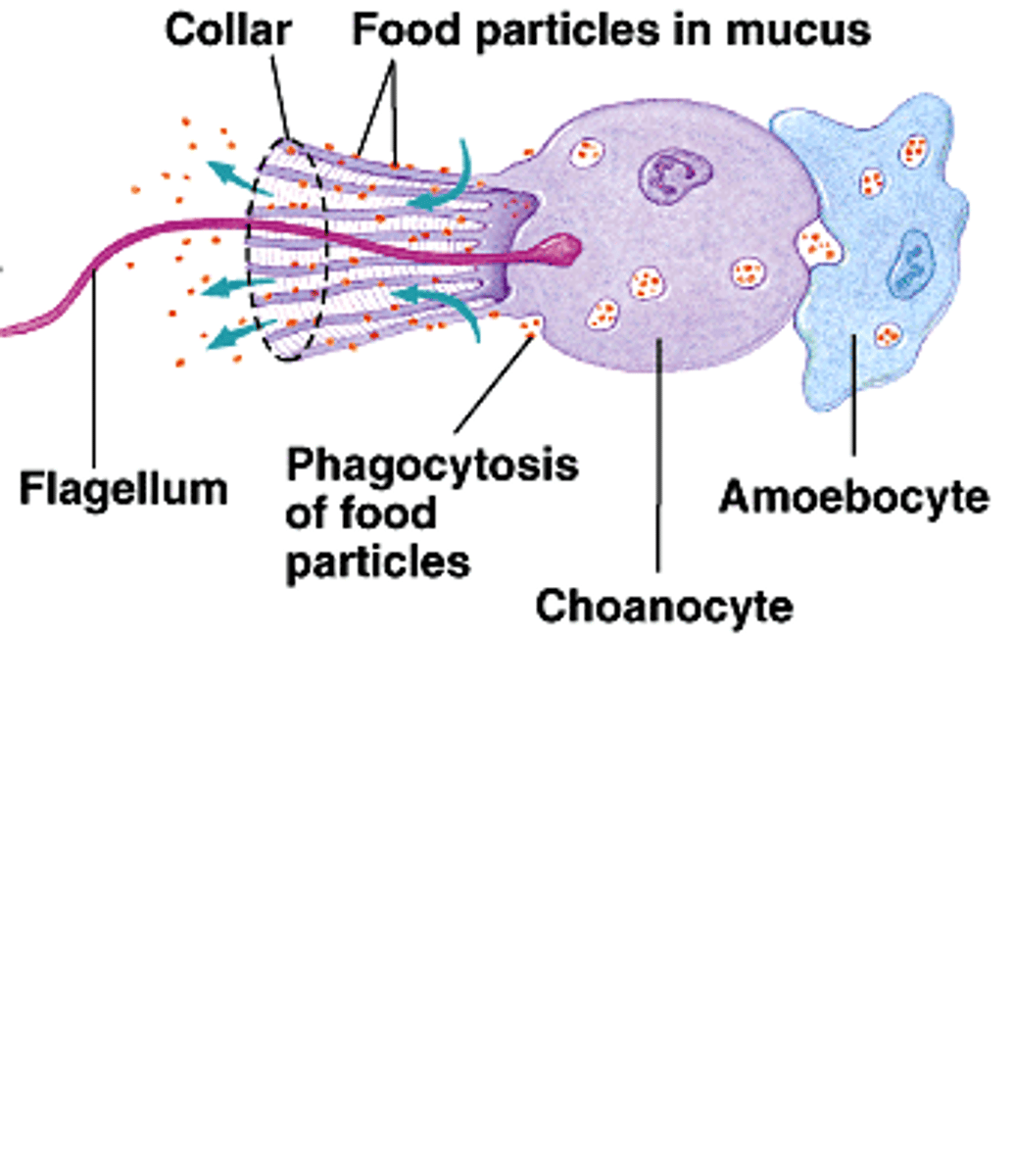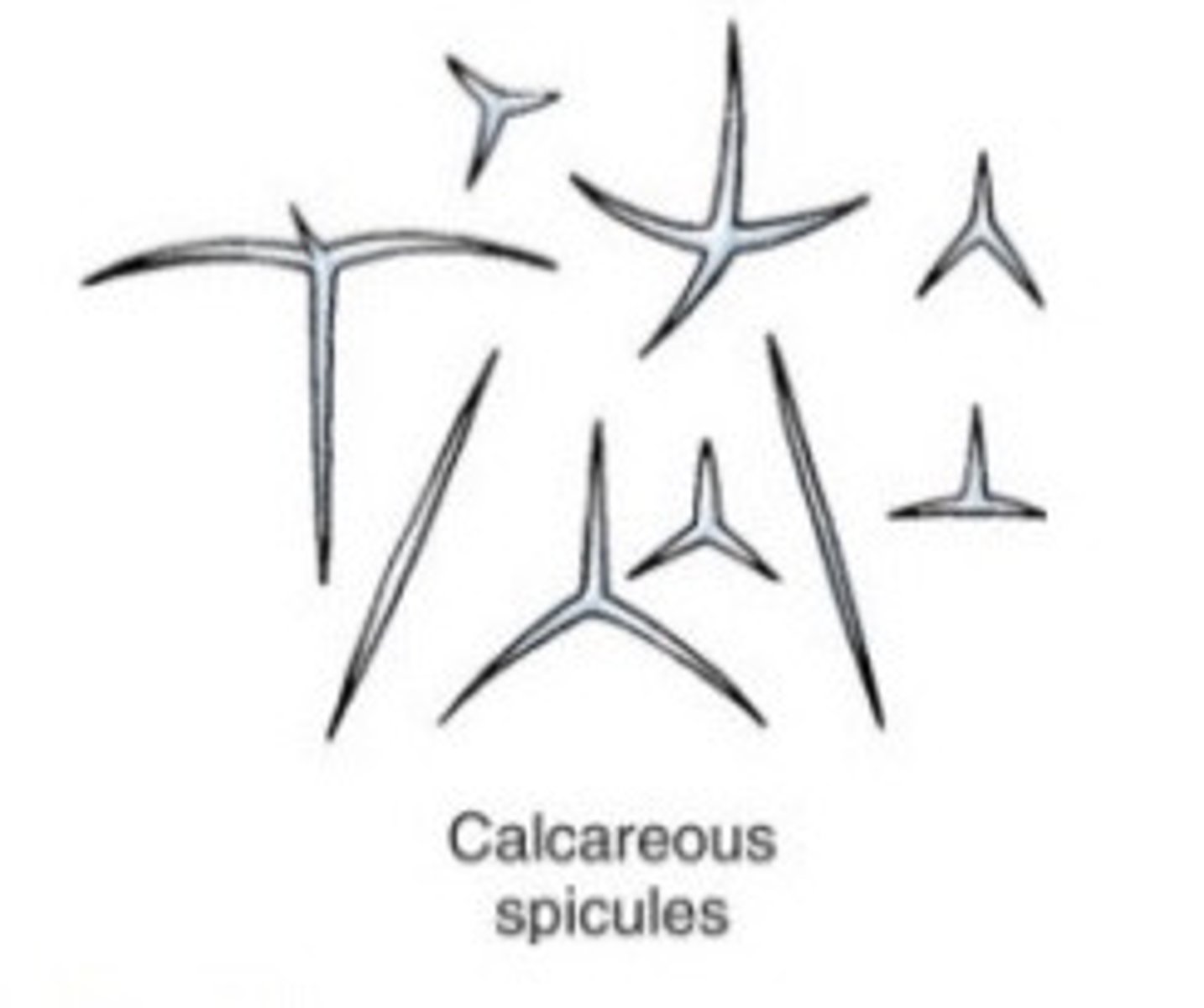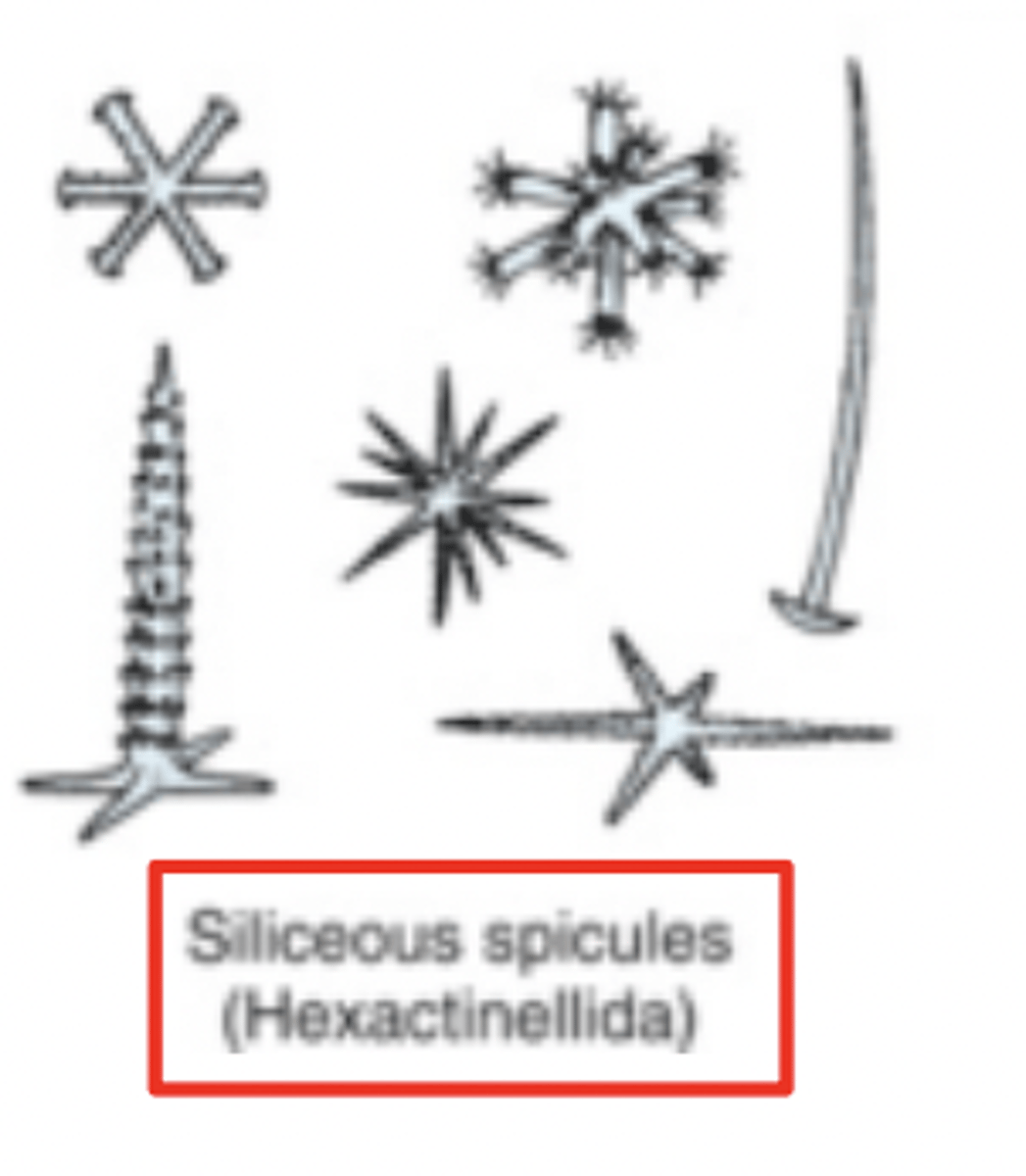BY 124L Topic 5: Kingdom Animalia Part 1
1/110
There's no tags or description
Looks like no tags are added yet.
Name | Mastery | Learn | Test | Matching | Spaced |
|---|
No study sessions yet.
111 Terms
What domain are we in when discussing animals?
Eukarya
What are some general characteristics of the Kingdom Animalia?
Eukaryotic, Heterotrophic, Carbohydrate Storage: Glycogen, Sexual Reproduction, NO CELL WALLS
Some animals can reproduce asexually, what are the three "forms" of asexual production by animals?
budding, fragmentation, parthenogenesis
What is budding?
a new individual grows on the parent then separates
What is Parthenogenesis?
the development of an egg into an embryo without fertilization
What is fragmentation?
in which a body part is lost and then regenerates into a new organism
What are the five characteristics in which the Phyla of the animal kingdom are characterized by?
1. body plan
2. type of symmetry
3. germ layers
4, body cavity
5. segmentation
What are the two types of body plans?
sac and tube in tube
What are the three types of symmetry?
asymmetry, radial symmetry, bilateral symmetry
What is radial symmetry?
symmetry around a central axis
What is bilateral symmetry?
body divides equally along one plane
What are the two types of germ layers?
2 layered and 3 layered
In a 2 germ layered organism, what are the two layers in it? What organization level is it?
ectoderm and endoderm, tissue level organization
In a 3 germ layered organism, what are the three layers in it? What organization level is it?
ectoderm, mesoderm, endoderm, organ level organization
What is the ectoderm?
the germ layer covering the embryo's surface
What is the mesoderm?
the middle layer of an embryo in early development, between the endoderm and ectoderm
What is the endoderm?
innermost germ layer
What are the three types of body cavities?
acoelomate, pseudocoelomate, coelomate
What is an acoelomate body cavity?
No body cavity between gut and outer covering
What is a pseudocoelomate body cavity?
Has a body cavity, but NOT completely lined with
mesoderm
What is a coelomate body cavity?
Has body cavity, completely lined with mesoderm
What are the two subkingdoms of Kingdom Animalia? What animals are included in each?
Parazoa (sponges), Eumetazoa (all other animals)
What is the Phylum under Subkingdom Parazoa?
Phylum Porifera (sponges)
What are some (6) characteristics of sponges?
no tissues, no organ systems, sac type body plan, asymmetrical, hermaphroditic, filter feeders
How are sponges (Phylum Porifera) hermaphroditic?
reproduce asexually (budding) or sexually, larvae is ciliated
What are the two types of filter feeders (Phylum Porifera)?
collar cells/choanocytes and amoebocytes
What are collar cells/choanocytes (Phylum Porifera)?
Have flagella that drive water past the cell, getting particles stuck to be digested, through the cells and out the osculum
What are amoebocytes (Phylum Porifera)?
Cells that wander the mesophyll (jelly-like layer between epidermal cells and the choanocytes), inside like stem cells and can differentiate to a lot of things
What do collar cells do for a sponge?
help filter sea water so the sponge can eat, breath, and excrete waste products

Amoebocytes will produce what? What does this define?
spicules, the class of the sponge
What are spicules?
Small structures within the sponge that give it support
What are the three classes of Phylum Porifera (sponges)?
Calcarea, Hexactinellida, Desmospongia
What is the Class Calcarea? Phylum Porifera
Calcium Carbonate Spicules (really tough like rocks, defense mechanism)

What is the Class Hexactinellida? Phylum Porifera
Silica Spicules

What is the Class Desmospongia? Phylum Porifera
Spongin Spicules (not rocks)

What are the phyla under the Sub Kingdom Eumetazoa?
Cnidaria, Ctenophora, Platyhelminthes, Rotifera, Nematoda, Nemertea, Mollusca, Annelida, Arthropoda
What are the Classes under the Phylum Cnidaria?
Anthozoa, Hydrozoa, Scyphozoa, Cubozoa
What are some characteristics (5) of the Phylum Cnidaria?
(anything with Cnidocytes) former name is Coelenterata, definite tissues, radial symmetry, nerve nets, gastrovascular cavity
What are DEFINITE tissues (Phylum Cnidaria)?
have a jelly-like layer between the epidermis and gastrodermis
What are nerve nets (Phylum Cnidaria)?
Non-centralized arrangement of neurons
What is a gastrovascular cavity?
Area where food is brought to be digested; digestions is EXTRACELLULAR, then taken into the cells by phagocytosis
Organisms under the Phylum Cnidaria have a stinging mechanism called what? What is this stinging mechanism?
Cnidocytes (cells unique to this phylum) contain a whip-like barb called nematocyts (organelles)
Organisms in the Phylum Cnidaria alternate between the _____ and the ________ stage
polyp and the medusa
What organizational level does the Phylum Cnidaria have?
tissue level
What are the five steps in the lifecycle of the medusa Jellyfish?
Medusa Jellyfish (the free-swimming adult form), the egg and sperm (are released by adults and meet in the water), planula larva (develops, in its short existence it is free-swimming), Polyp (settles on a hard surface and anchors itself, it grows over the winter), Polyp hydroid colony (forms, linked by feeding tubes, in the spring, polyps bud off tiny jellyfish)
What is a nematocyst? (Phylum Cnidaria)
fluid-filled capsule holding a coiled, hollow tube
What should you do if you get a jellyfish sting?
do not rub sand on it, use white vinegar (dislodges cnidocytes that have not activated and neutralize the sting)
What are some characteristics of the Class Hydrozoa? (Phylum Cnidaria)
Obelia (colonial form) is typical for this class, Hydra is the polyp stage - POLYP IS THE MAIN STAGE - Medusa stage is for sexual reproduction and Larva are called Planula (fire coral)
What are some characteristics of the Class Scyphozoa? (Phylum Cnidaria)
True Jellyfish, Medusa is DOMINANT Phase
What are some characteristics of the Class Cubozoa? (Phylum Cnidaria)
Box Jellies and Sea Wasps; Chironex fleckeri, Deadliest organisms off of North Australia, can kill within minutes; Sea turtles are somewhat immune to their sting and can eat them
What are some characteristics of the Class Anthozoa? (Phylum Cnidaria)
Polyp is only present stage; Corals and Sea Anemones; Skeletons of coral build reefs; Some have symbiotic relationship with algae (they are called zooxanthellae)
What causes coral bleaching?
oxybenzone (sunscreens), global warming (higher temps kill coral reefs), tourism (damage from divers)
What are some characteristics of phylum Ctenophora?
Comb Jellies (8 comb rows); Radial symmetry; Largest animal to use cilia for locomotion (Reflects light rays to look like it is glowing); Has tissue level organization
There is a major division with the lower invertebrates and the higher invertebrates/chordates, what are the two divisions? Based on what hole has become what
protosomes (lower invertebrates), deuterostomes (higher invertebrates/chordates)
What is the main difference between Protosomes and Deuterostomes?
in protosomes the blastopore becomes the mouth and in deuterostomes the blastopore becomes the anus
What are the three classes under the Phylum Platyhelminthes?
Tuberllaria, Tremetoda, Cestoda
What are some characteristics of the Phylum Platyhelminthes? (gastrovascular cavity?,type of digestion, circulatory /respiratory system?, mesoderm?, body type, body characteristic, type of body cavity, which subdivision)
flatworms, branched gastrovascular cavity, digestion is extracellular and intracellular, no circulatory or respiratory system, flame cells, has a mesoderm, nerve cords with ganlia, sac body, body is dorsal-ventrally flattened, they are acoelomates and protostomes
What are flame cells? (Phylum Platyhelminthes)
Perform excretion from the protonephridia/ flagellated
What are some characteristics of the Class Turbellaria? (Phylum Platyhelminthes)
Planaria; Mostly free-living; Has “eyespots” (Light sensitive regions, respond to light not sight); Capable of primitive learning
What are some characteristics of the Class Trematoda? (Phylum Platyhelminthes)
Flukes, all members are parasites on vertebrates, complex life cycles
What are some characteristics of the Class Cestoda? (Phylum Platyhelminthes)
Tapeworms; Head region is called the Scolex; Proglottids- Repeating "packages" of reproductive organs
What are some characteristics of the Phylum Rotifera? (unique characteristic, special organ, asexual reproduction form, where they live, symmetry type, body plan)
Rotifers (wheel animal), All members of same species have the same number of cells (cells not replaced); Grinding organ called a Mastax; Parthenogenesis; Fresh/marine water, terrestrial; Bilateral symmetry; Tube-in-tube body
What are some characteristics of the Phylum Nematoda?
Round Worms (Also hookworms, pin worms, filaria worms - Filaria worms cause elephantitis); Hydrostatic Skeleton; Trinchinella (Undercooked pork); Tube-in-tube body
What is a hydrostatic skeleton? (Phylum Nematoda)
a fluid-filled internal cavity surrounded by muscle tissue
What are some characteristics of the Phylum Nemertea?
Ceolomates; Proboscis worms (ribbon worms); Organs present; 3 germ layers; Differs from flat worms: One-way digestive system and Simple circulatory system; Tube-in-tube body
What are the 5 classes under the Phylum Mollusca?
Polyplachophora, Scaphopoda, Bivalvia, Gastropoda, Cephlopoda
What are some characteristics (5) common to all mollusks (Phylum Mollusca)?
Mantle- Fold of tissue that drapes over a visceral
mass; Calcium carbonate shell; Visceral mass- Mass containing the organs; Radula- Conveyer of teeth, used for scraping; Muscular foot- Movement
the Phylum Mollusca is the _____ largest animal phyla?
2nd
What is the largest animal phyla?
Arthropoda
What are some other characteristics of the Phylum Mollusca? (circulatory system type, Major organ systems?, body plan, hermaphrodites?)
Coelomates; open circulatory system, Major organ systems, Tube-in-tube body, Most have separate sexes, some are hermaphrodites
What are some characteristics of the Class Polyplacophora? (Phylum Mollusca)
Chitons; Shell is segmented, the ANIMAL IS NOT; Intertidal zones, radula to scrape algea
What are some characteristics of the Class Gastropoda? (Phylum Mollusca)
Snails, whelks, slugs, and nudibranchs (sea slugs); Mantle is highly vascularized for terrestrial forms; They perform a 180 degree "twist" of their organs during development
What are Nudibranchs (Class Gastropoda)?
bright colored extensions that warn off predators
What are some characteristics of the Class Bivalvia? (Phylum Mollusca)
Clams, oysters, scallops, mussels; No radula , filter feeders; Shell is divided into 2 halves
What is a characteristics of the Class Scaphopoda? (Phylum Mollusca)
tooth shells
What are some characteristics of the Class Cephalopoda? (Phylum Mollusca)
Octopuses, Squid, Chambered nautilus, cuttlefish; Foot is now a siphon; ONLY MOLLUSK WITH A CLOSED CIRCULATORY SYSTEM; Complex behavior, learning; Camera Eye (convergent evolution)
What is a squid? (Class Cephalopoda)
Shell reduced, 10 appendages, triangular head
What is an octopus? (Class Cephalopoda)
Shell absent, 8 appendages, round head
What is a chambered nautilus? (Class Cephalopoda)
Coiled Shell
What are some characteristics of the Phylum Annelida? (segment organs?, open or close circulatory system?, skeleton type?, body plan)
Coelomates; Segmented Worms - Each segment has a distinct organ, CLOSED circulatory system, Hydrostatic skeleton, Tube-in-tube body
What are some classes under the Phylum Annelida?
Polychaeta, Oligochaeta, Hirudenea, Grouping: Onchyophora
What are some characteristics of the Class Oligochaeta? (Phylum Annelida)
Earthworms; Improves soil texture; Hermaphroditic
What is the gizzard? (Class Oligochaeta)
muscular sac that grinds food in an earthworm
What is the crop? (Class Oligochaeta)
Diverticulum of the esophagus, used to store large quantities of food
What are some characteristics of the Class Polychaeta? (Phylum Annelida)
Fan worms and marine
worms; Parapodia- Highly vascularized paired appendages (Used for locomotion and gas exchange); Bobbitt worm
what are some characteristics of the Class Hirudinea? (Phylum Annelida)
Leeches; Most parasitic, but some are carnivores; Suckers on both ends; Most fresh water; Feed on blood
How do leeches feed on blood? (Class Hirudinea)
Dissolves/slices hole in skin; Secretes anesthetic while making hole; Secretes hirudin into wound that prevents coagulation
What are some characteristics of the Grouping Onychophora? (Phylum Annelida)
Velvet worm (Peripatus), have characteristics of Annelids and Arthropods (thought to be a link betwene phlya, more likely a weird arthropod)
What characteristics of Annelids does the Group Onychophora have?
Internal segmentation, jointed legs
What characteristics of Arthropods does the Group Onychophora have?
Jaws from appendages, open circulatory, chitin cuticle, respiratory system
What are some characteristics of the Phylum Arthropoda? (appendages types, leg characteristics, exoskeleton type and purpose, segment types, circulatory type, how respiration)
Coelomates; largest phyla group; jointed appendages; Modified legs for feeding, swimming, copulation, and
defense; Chitin exoskeleton (Allows for attachment of muscles, Must shed to grow); Fuse segments; Open Circulatory System; Respiration (Aquatic has gills, Terrestrial has internal systems)
The Phylum Arthropoda contains a hemocoel, what is this? What is a Hemolymph? How is the Coelom modified?
primary body that contains fluids; is a mix of blood and intestinal fluid; it is reduced
How does the Phylum Arthropoda fertilize? Is there a separation of sexes? Body plan?
internal fertilization, separate sexes, tube-in-tube body
What are the sub phylums under the Phylum Arthropoda?
Trilobitomorpha, Chiliceriformes, Myriapoda, Hexapoda, Crustaceans
What are some characteristics of the Subphylum Trilobitomorpha? (Phylum Arthropoda)
Trilobite, all extinct
What are some characteristics of the Subphylum Cheliceriformes? (Phylum Arthropoda) (examples, body layout, number of appendages, respiration, antennae/eye)
Horseshoe crabs, arachnids, sea spiders, ticks; Anterior cephalothorax followed by admen; 6 pairs of appendages; respiration - book lungs (arachnid), tracheal tubes (insects); no antennae, most have single lens eye
What is the first pair of appendages called for the Subphylum Cheliceriformes? What are they used for?
Chelicerae, Pincher like (claw mouth) that are NOT walking legs
What is the second pair of appendages called for the Subphylum Cheliceriformes? What are they used for?
Pedipalps, Used in feeding
What are the rest of the appendages called for the Subphylum Cheliceriformes? What are they used for?
Rest are walking legs, These are on the cephalothorax
What are some characteristics of the Class Merostomata? (Subphylum Cheliceriformes)
Horeshoe crabs; Most are extinct, "living fossils"